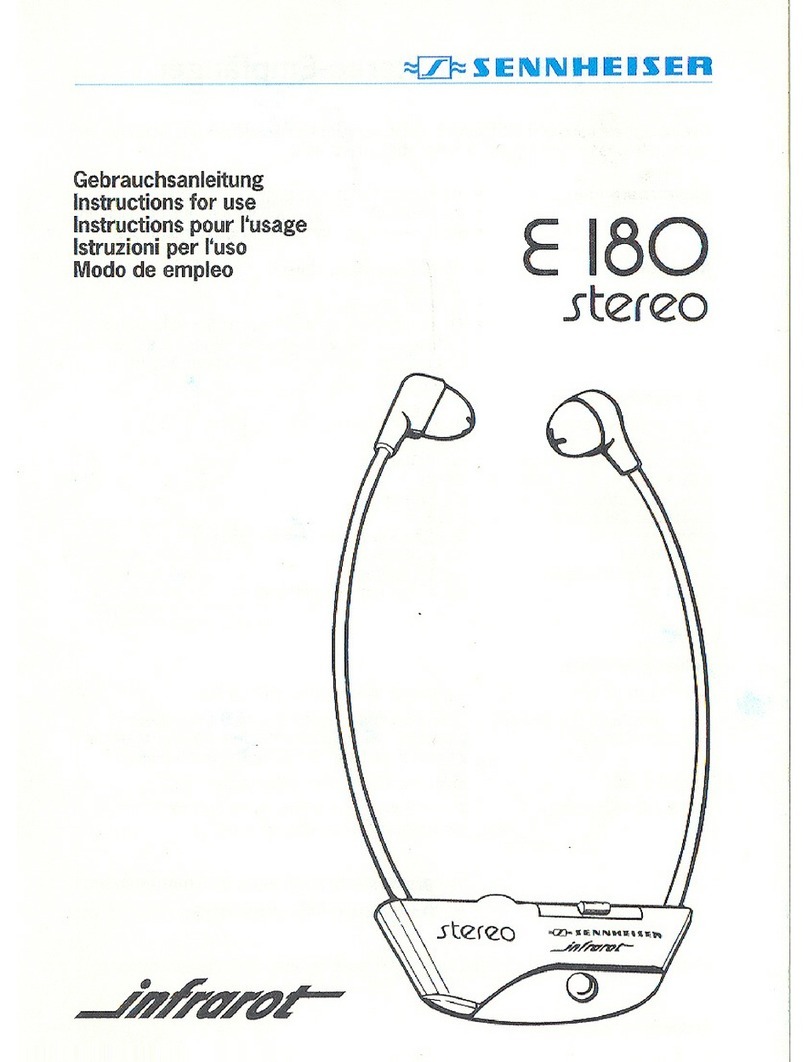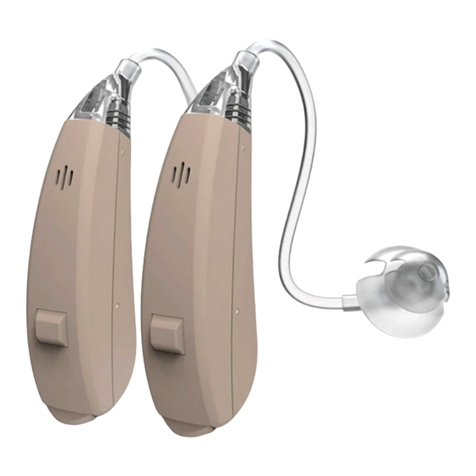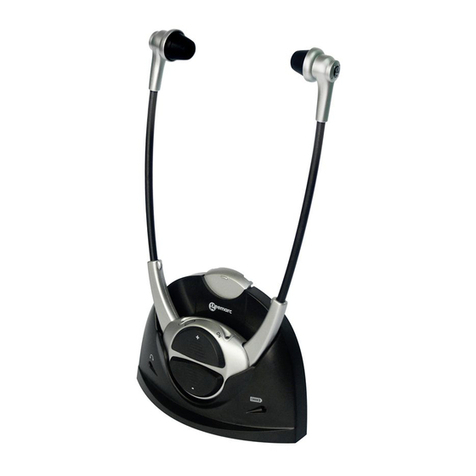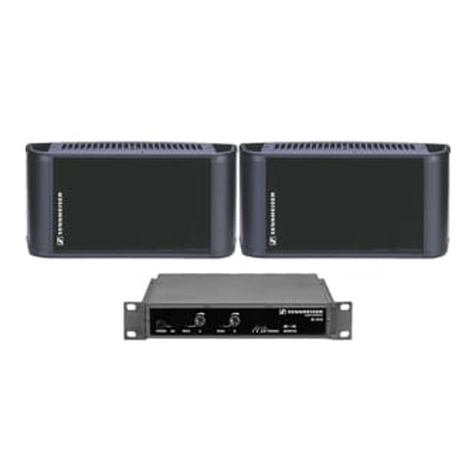Phonic Ear PE 210 User manual

PE 210 Sound Field System
User Instructions

C
ongratulations! You are now the owner of
the E
ASY
L
ISTENER
™
sound field system,
an innovative product designed to improve
listening environments through amplification.
Sound field amplification has been shown to:
• solve student listening problems
• improve academic performance
• reduce teacher vocal fatigue
• lower special education costs
Your new sound field system is very easy to use; however,
we recommend that you read the entire User Instructions
booklet to become familiar with all the features and benefits
your Easy Listener system offers.
This assitive listening system meets the relevant requirements of section 504 of the Rehabilitation
Act of 1973 and the Americans with Disabilities Act (ADA).
Phonic Ear and EASY LISTENER are trademarks of, and the exclusive property of Phonic Ear Inc.

TABLE OF CONTENTS
Getting Started
What You Need. . . . . . . . . . . . . . . . . . . . . . . . . . . . . . . . . 1
Installing AT578-S Speakers . . . . . . . . . . . . . . . . . . . . . . 1
Installing TheAT664 Ceiling Speaker . . . . . . . . . . . . . . . 3
Installing The PE 210R Receiver . . . . . . . . . . . . . . . . . . . 3
Using & Charging The PE 300T Transmitter . . . . . . . . . . 4
Features and Functions
PE 210R/210FSR Receiver. . . . . . . . . . . . . . . . . . . . . . . . 5
PE 300T Transmitter . . . . . . . . . . . . . . . . . . . . . . . . . . . . 7
AT664 Ceiling Speaker & AT578-S Speakers. . . . . . . . . . 9
Team Teaching Configuration . . . . . . . . . . . . . . . . . . . . . . . . 10
Accessories . . . . . . . . . . . . . . . . . . . . . . . . . . . . . . . . . . . . . . . . 11
Trouble Shooting Guide . . . . . . . . . . . . . . . . . . . . . . . . . . . . . 13
Frequency Reference Chart. . . . . . . . . . . . . . . . . . . . . . . . . . 14
Caring for Your Sound Field System . . . . . . . . . . . . . . . . . . 15
Warranty . . . . . . . . . . . . . . . . . . . . . . . . . . . . . . . . . . . . . . . . . 16

1EASY LISTENER by Phonic Ear
GETTING STARTED
I
NSTALLING THE
AT578–S S
PEAKERS
The location and position you select for
your AT578-S Speakers will play an
important role in the room’s overall sound
quality. Everything from furniture to room
configuration can effect sound dispersion.
Therefore, it is a good idea to experiment
with a number of possible locations before
you decide on the final arrangement.
Ideally, speakers should be mounted on
walls near the ceiling; however, the speakers
may also be placed on a flat surface (such as
a bookcase) or mounted to speaker stands.
Consider the following suggestions when
determining speaker location:
• Avoid placing speakers flush with corner
walls or ceiling (see Figures 1 and 2).
• The speakers should be placed against
the wall, approximately 8 to 12 ft
(2.5m to 3.5m) above the floor.
• The speakers should be angled to point
toward the listeners’ ear level.
• Place speakers so that the sound trans-
mission is equal for all individuals in
the listening area.
• Position speakers so that furniture does
not block sound dispersion.
• Avoid placing speakers directly opposite
each other or opposite a large reflective
surface; stagger them instead (see Figures
3 and 4).
When you’ve established suitable locations
for your speakers:
• Connect a speaker cable to each speaker,
matching black to black and red to red for
correct polarity.
AT534 Wall Transformer/
Two-Unit Charger
PE 300T Transmitter
with AT655 BTN Microphone
or other appropriate mic
W
HAT
Y
OU
N
EED
To start using your new sound field system, make sure you have these items:
PE 210R or PE 210FSR Receiver
with AT577 Wall Transformer and Antenna
AT578-S Speakers with
AT581 Speaker Cable
(1 per speaker)
AT664
Ceiling Speaker
with AT581 Cable
O
R

2
Sound Field System User Instructions
GETTING STARTED
Figure 3 (Top View) Figure 4 (Top View)
NO YES
Figure 1 (Top View) Figure 2 (Side View)
NO YES
❒ Does set-up deliver a uniform and clear
sound signal?
❒ Is there any feedback?
❒ Are cables secured to the walls?
❒ Is speaker angle pointing at the listeners’
ear-level when seated?
❒ Is equipment located in areas away
from excessive heat or cold, wetness,
or open windows?
❒ Are you using the proper hardware to
secure the speakers?
❒ Does your installation meet local electric
and fire department codes?
Before permanently installing speakers, check each of the following:
Speaker Placement Checklist
wall ceiling
wall
wall
wall
wall
wall
wall
wall
wall

3EASY LISTENER by Phonic Ear
GETTING STARTED
I
NSTALLING
AT664 C
EILING
S
PEAKER
Please follow these recommendations to
enhance the speaker’s overall performance.
• Consult with a professional sound
contractor or electrician before installation.
• Select a ceiling position over the central
listening area for best coverage.
• Leave a distance of at least one foot from
lighting transformers to avoid interference.
• If possible, remove obstructions in the
path of the sound, or add another speaker
to cover the affected zone.
• Remove a 2 ft x 2 ft (61cm x 61cm)
ceiling tile.
• Insert the speaker unit into opening,
placing the edge of speaker onto the
ceiling grid.
• Always attach the speaker to a structural
component above the ceiling with a min-
imum of two safety wires. (see Figure 5).
• Insert one end of the AT581 speaker cable
into the crimp connector of the ceiling
speaker wire. (Connect black to black and
red to red for correct polarity). Crimp the
connection using pliers or other tool.
I
NSTALLING THE
R
ECEIVER
• Position the PE 210R Receiver near a
wall outlet that is central to the location
of the speakers, and verify that the power
switch is in the off position. Plug in the
AT577 Wall Transformer.
NOTE: Install your sound field receiver at
least 5 feet away from digital equipment (such
as computers or CD players) to avoid inter-
ference or possible loss in effective range.
•
Run speaker cables to the receiver, making
sure they are against a wall and out of the
way of foot traffic.
• Connect the speaker cables to the speaker
terminals on the back of the receiver.
Connect black to black and red to red for
correct polarity.
• Connect the antenna to the antenna jack
located on the back of the receiver.
• Set the FM VOL control and AUX VOL
control on the receiver to the minimum
level (counter-clockwise). Adjust the
TONE control to the center position.
NOTE: If using the PE 210FSR Receiver,
select the operating channel that matches
the transmitter channel by sliding the
channel selection switch located on the
bottom of the Receiver. (See page 6)
Mounted Top View
Safety Wires
Figure 5
NOTE: GVC, SD Technologies, and Phonic Ear Inc. are not responsible for the structural integrity of the
installation. This drawing is not intended for use as an engineering design specification or for loading calculations.

4
Sound Field System User Instructions
• Switch the receiver POWER control on.
The receiver is now ready to receive the
FM signal from the transmitter. The ON
and NO FM lights will be on.
U
SING THE
T
RANSMITTER
The transmitter will need to be charged
overnight or for at least 12 hours prior
to the first use. (Batteries are protected
from over-charging.)
• Plug the microphone into the MIC jack
of the transmitter.
• If using the AT655 Behind-the-Neck
microphone, position the microphone
over the left ear and slightly below the
mouth. If using a lapel microphone, clip
it to clothing or adjust the lavalier cord
so that it is no further than 6 in (15cm)
below your chin.
• Turn the transmitter’s ON/OFF switch to
the ON position, and verify that the red
NO FM light on the receiver is off.
• The transmitter/microphone is now
ready to accept your speech signal.
• Adjust the receiver’s FM VOL and TONE
controls while speaking into the transmitter
and listening to the speakers. As a general
rule, increase treble in a sound-absorptive
room (i.e., one with carpet, soft furniture,
etc.), and decrease treble in a sound-
reflective room (i.e., one with hard walls,
floors, furniture, etc.). (See page 5.)
If feedback occurs, reduce the FM VOL
and/or reduce the TONE control setting.
• Make installation a team effort —have
one person speak into the transmitter
while another checks the sound quality
in various locations around the room.
Adjust the speaker position if necessary.
C
HARGING THE
T
RANSMITTER
CAUTION: Do not recharge disposable
or rechargeable alkaline batteries–they
may rupture and damage the unit.
• To charge the PE 300T Transmitter first
verify that the ON/OFF switch is in the
OFF position.
• Then, plug one of the two mini plugs
of the AT534 Charger/Transformer into
the AUX/CHG jack of the transmitter.
(You may charge up to two transmitters
at once.) Next, connect the wall plug end
of the Charger/Transformer to a wall
socket. The Transmitter’s AUX/CHG
light should come on indicating the unit
is being charged.
• After charging, disconnect the charger
from the transmitter.
GETTING STARTED
AT534 Wall Transformer/
Two-Unit Charger
PE 300T Transmitter
with AT655 BTN Microphone
or other appropriate mic

5EASY LISTENER by Phonic Ear
PE 210R / PE 210FSR R
ECEIVER
Front Panel
1. Power Switch
Turns the unit on and off.
2. ON Indicator Light
Lights when the unit is on.
3. NO FM Indicator
A red lamp will light when the
receiver is on, but no FM signal
is being received.
4. FM VOL Control
Controls the sound level received
from the PE 300T Transmitter.
5. AUX VOL Control
Controls the sound level received from
tape players, TVs, or other equipment
plugged into the AUX INPUT jack on
the back of the receiver.
6. Tone Control
Allows the system to be adjusted
for best performance in various
listening environments. Turn the
knob clockwise to increase treble,
and counter-clockwise to increase
bass. Place knob in the center for a
mid-range tone.
Rear Panel
7. Power Jack
Provides power to the receiver from
the AT577 Wall Transformer.
8. Speaker Output Terminals
Push terminals allow for connection
of up to four 8-ohm AT578-S
Speakers, or up to two AT664 Ceiling
Speakers. Black and red color-coding
ensures correct polarity.
FEATURES AND FUNCTIONS
Front View
456321

Sound Field System User Instructions 96
FEATURES AND FUNCTIONS
Back View
78 9 10 11
1213
PE 210FSR
9. AUX Input Jack
Allows external sound sources (such
as a cassette recorder or television)
to be broadcast over the system’s
speakers. Also enables connection
of a PE 300R or PE 350FSR Receiver
for team teaching presenters—
allowing two different signals to be
broadcast simultaneously through the
PE 210 or PE 210 FSR receiver.
10. Antenna Jack
Connects the antenna to the
receiver for reception of the
transmitted FM signal.
11. Channel Number (PE 210R only)
Identifies the operating channel of
the PE 210R Receiver. Transmitter
and receiver channel numbers must
match for the units to operate together.
12. FSR Indicator (PE 210FSR only)
Identifies the unit as a PE 210FSR
frequency selective receiver,
allowing for selection of any one
of six FM narrow-band receiver
frequencies for greater flexibility.
13. Frequency Selector Switch
(PE 210FSR only)
This switch (located on the bottom
of the PE 210FSR Receiver) permits
selection of any one of six FM
narrow-band operating channels.
Three standard channel groupings
are available in the frequency band.
(See the Frequency Reference
Chart on page 14.)

9EASY LISTENER by Phonic Ear
7
FEATURES AND FUNCTIONS
Front View
1
4
5
PE 300T T
RANSMITTER
1. Power Switch
Turns the unit on and off.
2. MIC Jack
Used to connect microphones avail-
able for the PE 300T Transmitter. To
connect a microphone, insert plug into
the MIC jack of the transmitter. (The
MIC cord also serves as the antenna.
To ensure optimum reception, do not
coil or tangle the cord during use.)
NOTE: When an external
microphone is not being used, the
AT529 Antenna must be plugged into
the MIC jack for proper transmission.
3a. AUX Input Jack
For connecting an external sound
source such as a cassette recorder,
CD-player or TV via the AT532
Auxilliary Input cord.
3b. Charge Jack
Accepts the AT534 Charger / Wall
Transformer for recharging NiCad
batteries. Always turn the unit off
prior to recharging (unit will charge
if left on,
but more charging time
will be required).
4. Charging Indicator
A red light will indicate that the
unit is being recharged.
23a,b
Top View

8
Sound Field System User Instructions
Back View
6
7
5. Channel Number
Identifies the operating channel of
the unit. Transmitter and receiver
channel numbers must match for the
units to operate together.
6. Battery Compartment
Houses two AA-size rechargeable
NiCad or disposable alkaline
batteries used to power the unit.
(Caution: Do not recharge
disposable or rechargeable Alkaline
batteries–they may rupture and
damage the unit.) When replacing
batteries, carefully note the markings
inside the battery compartment for
proper placement.
Transmitter operating life: 8 hours
with rechargeable NiCad batteries;
20 hours with alkaline batteries.
7. Belt Clip
Designed to conveniently attach
the transmitter to a belt. The transmitter
may also be placed in a pocket or hip
pack as long as the microphone cord/
antenna is not bent, coiled, or twisted.
FEATURES AND FUNCTIONS

9EASY LISTENER by Phonic Ear
9
FEATURES AND FUNCTIONS
Front View
Back View
2
1
3
4
5
AT664 C
EILING
S
PEAKER
This 4-way speaker unit disperses sound
through four full-range 8 in (20cm)
speakers with 180˚ by 360˚ coverage.
Total coverage is determined by the
height of the ceiling. A maximum of two
ceiling speakers may be connected to the
E
ASY
L
ISTENER
receiver to increase
coverage as needed.
The speaker’s patented design eliminates
“hot” spots and minimizes areas of drop
out to guarantee the most even distribution
of sound.
AT578-S S
PEAKERS
1. Speaker Switch
Allows speakers to be muted.
2. Speaker Input Terminals
Push terminals allow for connection
of speaker cable. Black and red color
coding ensures correct polarity.
3. Speaker Cable Strain Relief
A pull-out spring retainer holds
speaker cable securely to prevent
accidental disconnection.
4. Wall Bracket Mounts
Allows speakers to be mounted
on walls. When mounted vertically,
the speaker can be adjusted from
side to side. When mounted hori-
zontally, the speaker can be positioned
up or down.
5. Speaker Stand Adapter (optional)
Allows speaker to be mounted to
the AT579 Speaker Stand for conven-
ient placement around the room.
Front View

10
Sound Field System User Instructions
TEAM TEACHING CONFIGURATION
R
EQUIRED
E
QUIPMENT
• An additional 300R AND 300T with mic.
• One AT653 AUX input cord.
First Teacher
Second Teacher
The first teacher’s transmitter
channel matches that of the
210R or 210FSR
The second teacher’s transmitter
channel matches that of the 300R
Receiver plugged into AUX input
jack of the 210R/FSR via the
AT653 input cord.
Team teaching is a great way to maximize
learning. Because two teachers can divide
their time among students, team-taught
classes can offer children more learning and
participation opportunities than would be
possible in a traditional setting.
Adding amplification to the team-teaching
strategy can make it even more effective.
Here’s how:
AT653 AUX input cord
9
24
300R Receiver
NOTE: Teachers may need to adjust the
FM VOL and AUX VOL controls on the
Sound Field receiver and the VOL control
on the personal receiver to achieve a
comfortable balance.

9EASY LISTENER by Phonic Ear
11
ACCESSORIES
AT291-W
Windscreen
AT291 Directional
Microphone w/Mic
Clip and Lavalier Cord
AT655
Behind-the-Neck Mic
TRANSMITTER WEARING OPTIONS
TRANSMITTER MISCELLANEOUS
AT534
Two-Unit Charger/
Wall Transformer
AT544
2AA Rechargeable NiCad
Batteries
AT529
Mic Jack Antenna
AT532 Auxiliary Input Cord
5 ft or 15 ft (1.5 m or 4.6 m) lengths
AT489
Wire Belt Clip
AT594 Hip Pack
AT076 Plastic
or AT512 Rope
Lavalier Cord
TRANSMITTER MICROPHONE OPTIONS

12
Sound Field System User Instructions
ACCESSORIES
RECEIVER
SPEAKERS
CARRYING CASE
ANTENNA
AT617 37 MHz
AT565 72 MHz
AT566 173 MHz
AT580
System Carrying Case
AT653
AUX Input Cord
30 in (76 cm)
For use with dual presenters
or with secondary audio sources
AT577
Wall Transformer
AT578-S
Speaker
AT579
Speaker Stand AT582-FM
Speaker
Stand Adapter
AT664
Ceiling Speaker
AT581 Speaker Cable
24, 48, & 60 ft
(7, 15, & 18 m) lengths

13 EASY LISTENER by Phonic Ear
TROUBLE SHOOTING GUIDE
SYMPTOM CHECK THE FOLLOWING
No FM Reception Check that the transmitter is turned on.
(NO FM light on receiver stays on) Verify that the channel number of the
transmitter and the receiver are the same.
Verify that the channel selector switch (on the
PE 210FSR) is set correctly. Refer to page 6.
Verify that the receiver antenna is attached.
Recharge or replace the transmitter’s batteries.
Verify that the microphone is working.
(Test with another working microphone.)
Feedback Lower the FM VOL control on the receiver.
Reduce the TONE control adjustment on
the receiver.
Make sure that the person wearing the 300T
Transmitter is not too close to the speakers.
Verify that only the AT291 Directional
Mic or AT655 Behind-the-Neck Mic is being
used with the 300T Transmitter.
Weak Output from Speaker(s)
Increase FM and/or AUX VOL control.
Check that none of the AT578-S Speakers is
blocked or covered.
Reposition the microphone closer to
the speaker’s mouth.
Place the AT578-S Speakers closer to the
listeners (see speaker placement suggestions
on page 2).
Verify that the AT664 Ceiling Speaker has
been properly installed.
Receiver Won’t Turn On Verify that the wall transformer is plugged
(Power light doesn’t turn on.) into a working wall outlet.
Test with another AT577 Wall Transformer.
No sound from one speaker Verify that the speaker switch is in the ON position.
Verify that speaker cables are connected
at the speaker and receiver terminals.
Replace speaker in question.
Disconnect speaker cable and reconnect
with a new cable.

14
Sound Field System User Instructions
72 MHZFREQUENCY REFERENCE CHART
FREQUENCY COLOR CHANNEL BAND
MHz CODE NUMBER
72.025 Red/Gray 1
72.075 Brown/Gray 2
72.125 Red/Brown 3
72.175 Brown/Red 4
72.225 Orange/Gray 5
72.275 Brown/Orange 6
72.325 Orange/Brown 7
72.375 Brown/Yellow 8 LOW
72.425 Yellow/Gray 9
72.475 Brown/Green 10
72.525 Yellow/Pink 11
72.575 Brown/Blue 12
72.625 Yellow/White 13
72.675 Brown/Pink 14
72.725 Green/Gray 15
72.775 Brown/White 16
72.825 Green/Brown 17
72.875 Black/Gray 18
72.925 Green/Red 19
72.975 Black/Brown 20
74.625 White/Brown 33
74.675 White/Red 34
74.725 White/Orange 35
74.775 White/Yellow 36 MEDIUM
75.225 White/Green 37
75.275 White/Blue 38
75.325 White/Pink 39
75.375 White/Black 40
75.425 Black/Orange 21
75.475 Green/Yellow 22
75.525 Black/Yellow 23
75.575 Green/Blue 24
75.625 Black/Green 25
75.675 Green/Pink 26 HIGH
75.725 Black/Blue 27
75.775 Green/Black 28
75.825 Black/Pink 29
75.875 Pink/Gray 30
75.925 Black/White 31
75.975 Pink/Yellow 32
NOTE: Channels shown in bold face type are the 6 standard channel
groupings (low, medium and high) used on the PE 210 FSR receiver.

15 EASY LISTENER by Phonic Ear
CARING FOR YOUR SYSTEM
C
LEANING
Clean as needed, using a soft damp cloth.
S
TORAGE
Clean with a soft damp cloth and remove
the batteries from the transmitter. Place the
system into an AT580 carrying case or
original packaging.
O
THER
I
MPORTANT
N
OTES
• Protect your sound field system
from excess moisture, heat, and
mechanical shocks.
• The case bottom of the PE 210R and
PE 210FSR receivers, as well as the
AT577 wall transformer can get warm
under normal operation.
• To protect the transmitter’s case
front, position it face down on a soft
surface when removing or inserting
the batteries.
• Always dispose of old batteries in
approved battery recycling bins. It may
be illegal to dispose in the trash. If you
are not sure of proper disposal method,
please consult your local authority.
Phonic Ear FM receivers and FM transmitters are approved by the Federal Communications
Commission in the U.S., and Industry Canada. Other government approvals available upon request.
(Other international regulations may also apply.)
NOTE: FCC Rules, Part 15, Subpart A, 15.19 (a)(3) and (c.) This device complies with part 15 of the
FCC rules. Operation is subject to the following two conditions: (1) this device may not cause harmful
interference, and (2) this device must accept any interference received, including interference that may
cause undesired operation.
Any changes or modifications made to any government approved element of this FM wireless system,
without the expressed approval of Phonic Ear Inc. in writing, could void the user’s authority to operate
those elements of the system.
If any changes or modifications are made it will be the responsibility of the party performing the
changes or modifications to ensure continued compliance with the FCC regulations and they are required
to: (1) File for a new equipment authorization, or (2) Relabel the product(s) with “This product has been
modified by [insert the name, address and telephone number of the party performing the modification].”

16
Sound Field System User Instructions
WARRANTY
A one-year limited warranty is issued to the
original consumer of this product(s) by:
Sales and Service Service Only Sales and Service
Western U.S. / International Eastern U.S. Canada
Phonic Ear, Inc. Phonic Ear, Inc. Phonic Ear, Ltd.
3880 Cypress Drive 9140-K Guilford Road 10-7475 Kimbel Street
Petaluma, CA 94954-7600 Columbia, MD 21046-1890 Mississauga, Ontario
U.S.A. U.S.A. L5S 1E7 Canada
800-227-0735 800-638-2680 800-263-8700
707-769-1110 301-725-8883 905-677-3231
707-769-9624 FAX 301-725-3754 FAX 905-677-7760 FAX
T
IME
P
ERIOD OF
W
ARRANTY
This warranty will go into effect upon the date of original purchase of this equipment and
will remain in effect for one calendar year from that date as long as the instrument remains
the property of the original consumer.
W
HAT IS
C
OVERED BY
T
HIS
W
ARRANTY
Any electronic component which, because of workmanship, manufacturing, or design defects,
fails to function properly under normal use during the life of this warranty will be replaced
or repaired at no charge for parts or labor when returned to the factory service center.
Transportation of defective components to the service center is paid by the customer. If it is
determined that repair is not feasible, the entire unit may be replaced with an equivalent unit
upon mutual agreement of the manufacturer and customer.
W
HAT IS NOT
C
OVERED BY
T
HIS
W
ARRANTY
This one-year limited warranty does not apply to:
1. Malfunctions resulting from abuse, neglect, or accident.
2. Peripheral accessories as itemized within the product brochure, when such items are
returned after 90 days from the original purchase.
3. Alkaline batteries, if applicable.
4. Instruments connected, installed, used or adjusted in a manner contrary to instructions
provided by the manufacturer.
5. Consequential damages and damages resulting from delay or loss of this instrument.
The exclusive remedy under this warranty is strictly limited to repair or replacement
as herein provided.
6. Products damaged in transit unless investigated by the shipper and returned to the
warrantor with the investigation report.

Sales and Service Service Only Sales and Service
Western U.S. / International Eastern U.S. Canada
Phonic Ear, Inc. Phonic Ear, Inc. Phonic Ear, Ltd.
3880 Cypress Drive 9140-K Guilford Road 10-7475 Kimbel Street
Petaluma, CA 94954-7600 Columbia, MD 21046-1890 Mississauga, Ontario
U.S.A. U.S.A. L5S 1E7 Canada
800-227-0735 800-638-2680 800-263-8700
707-769-1110 301-725-8883 905-677-3231
707-769-9624 FAX 301-725-3754 FAX 905-677-7760 FAX
© 1997 Phonic Ear Inc. 821-6380-103 597
Table of contents
Other Phonic Ear Hearing Aid manuals

Phonic Ear
Phonic Ear HearIt Media User manual
Phonic Ear
Phonic Ear sprite PE 800R User manual
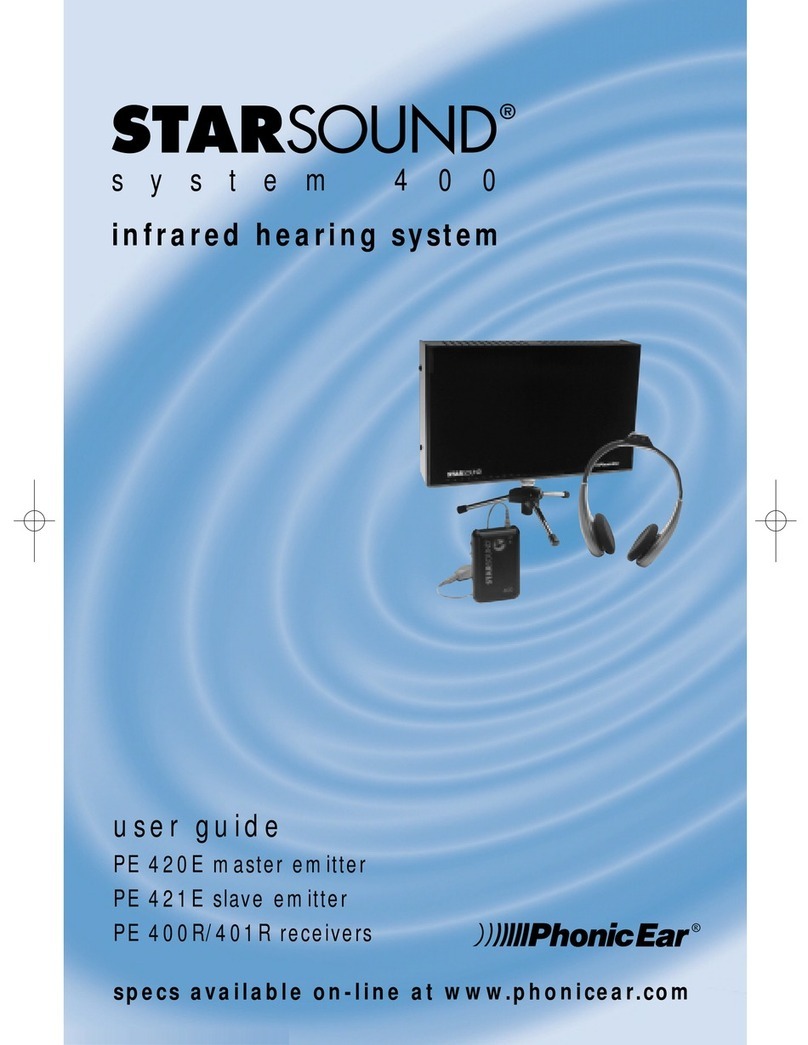
Phonic Ear
Phonic Ear PE 400R User manual

Phonic Ear
Phonic Ear LEXIS User manual

Phonic Ear
Phonic Ear Hearit M User manual

Phonic Ear
Phonic Ear FTS01 Instruction Manual
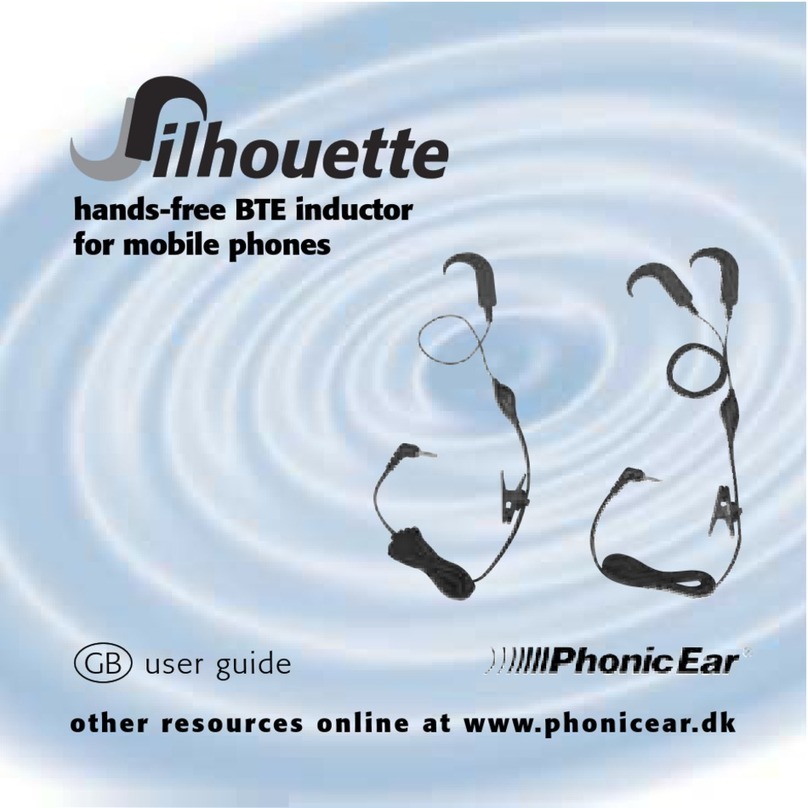
Phonic Ear
Phonic Ear Silhouette User manual
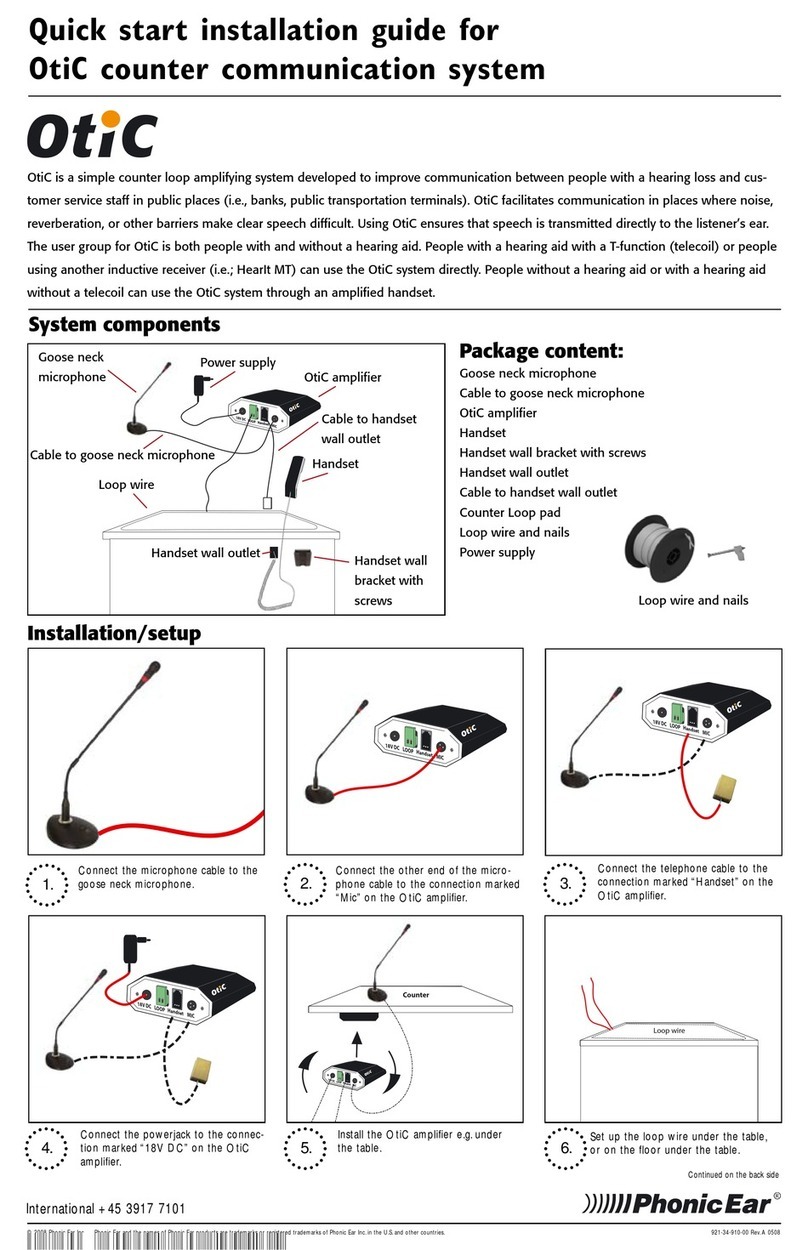
Phonic Ear
Phonic Ear OtiC Instruction Manual
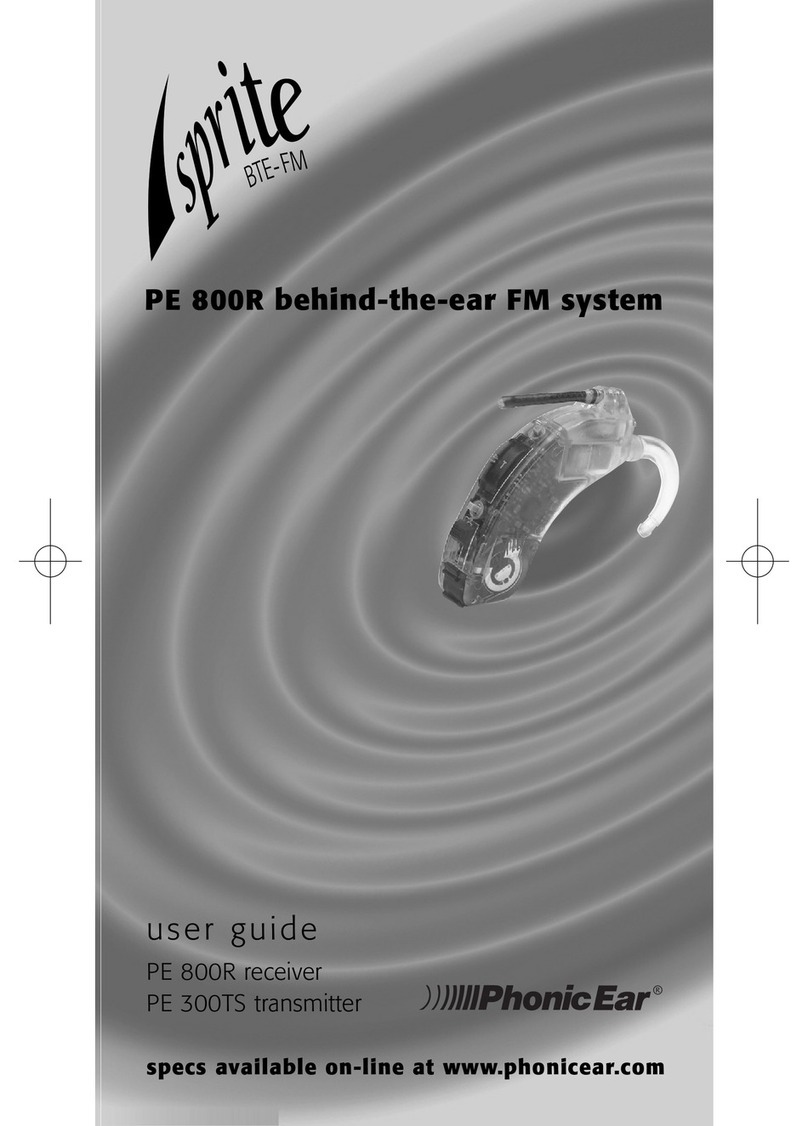
Phonic Ear
Phonic Ear PE 800R User manual
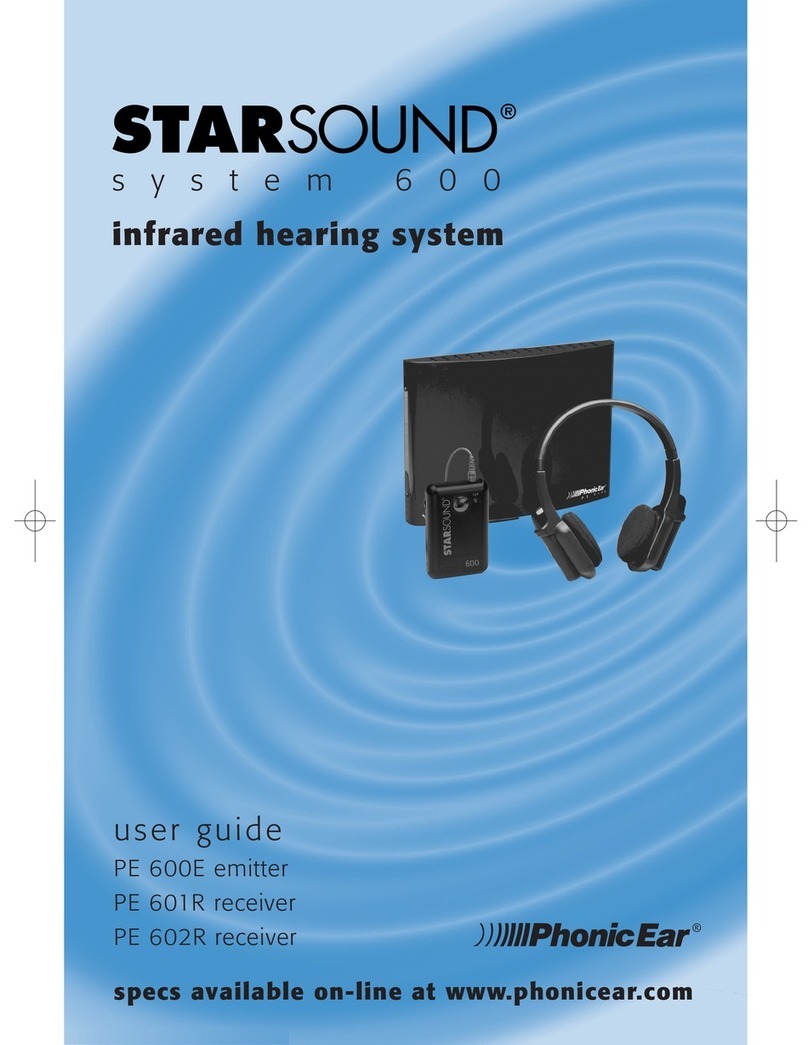
Phonic Ear
Phonic Ear PE 602R User manual







